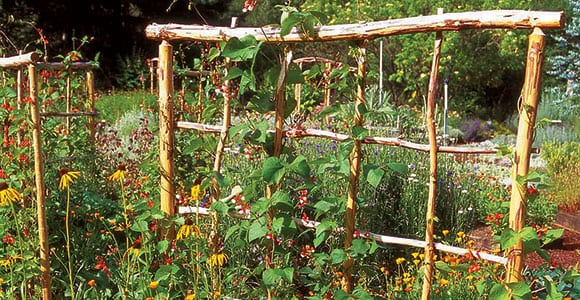Take advantage of garden space by using the third dimension to grow vegetables and other edibles
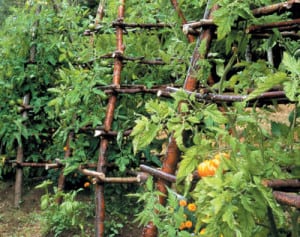
When garden space is limited, you can still grow space-hungry vegetables such as squash, melons and prolific tomatoes. Growing vegetables and vining fruits on an arbor or vertical trellis is the most efficient way to add space in a less-than-spacious garden. Not only will you be able to grow more produce in less space, but the added sun and air on plant surfaces will help bring a superior quality to the produce.
Growing vertically improves air circulation, which helps minimize mildew and other plant diseases. Trellising also eliminates soil contact so vegetables and fruits stay cleaner and are less likely to rot. Fruits are quicker to ripen and often more flavorful due to the additional sunlight exposure. And since the veggies and fruits are more visible and not hidden beneath lush growth, they can be harvested at their peak of perfection.
Trellising also saves strain on your back as there is minimal stooping, bending or hunching over needed to harvest crops. And just imagine the extra watering, weeding and feeding it would take to grow enough bush beans or peas to equal the yield that pole varieties produce when grown on vertical supports.
Getting started
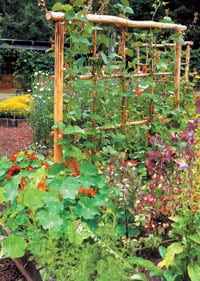
Before setting up any type of trellis system, amend the soil with lots of rich compost or well-rotted manure prior to planting. This is key to producing optimum yields in a smaller space. By enriching the soil, you will improve its tilth and fertility and help get plants off to a good start.
Where and how you situate your trellis system is equally important. Keep in mind that plants grown vertically will cast a shadow. Running your trellis in an east-to-west direction on the north side of your garden will create optimal light exposure for trellised plants while casting the least amount of shadow in the garden. Shadows cast over neighboring sun-loving crops can be minimized by running your trellis in a north-to-south direction, though vertical plants on the northern end of the trellis will receive less light than plants on the southern end.
A few shadows are inevitable but can become an asset if you use them to your advantage by planting shade-tolerant crops such as lettuce, spinach and other heat-sensitive vegetables, flowers and herbs near a plant-laden trellis.
Standing tall
A variety of trellis systems can be used to grow vegetables vertically — from cages and hog panels to poles, stakes and strings and store-bought trellises and arbors. Plants are typically grown up plastic or string mesh, chicken wire, hog panels or hand-strung twine or wire attached to trellis supports made of metal, wood, bamboo, plastic or PVC pipe.
My favorite material for trellising plants is a hog panel or cattle panel. These are basically sections of fencing made of galvanized, heavy wire. Cattle panels are usually about 5 feet tall with square openings about 6 inches across. Hog panels are about 3 feet tall, with top square openings about 6 inches across that get progressively smaller lower to the ground. Available at farm supply stores, they provide an inexpensive way of creating a long-lasting and rust-resistant trellis.
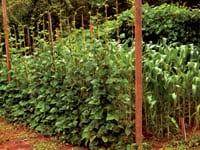
You can position panels to form an A-frame secured at the top or run panels upright and secure them to metal posts spaced about 5 feet apart in a row, attaching the panel to each post with heavy-duty wire or zip ties. To raise the trellis height to 6 feet tall, simply attach the panel 2 feet off the ground.
Whether you place your trellis horizontally or vertically, growing certain crops off the ground will expand your gardening options for space-hungry vegetables and fruits. Either way, your garden — and the bounty it provides — will soar to new heights of satisfaction.
Trellis types
There are many different types of trellis systems. Here’s an overview of some of the most useful setups for vertical gardening:
Cages: Often used for growing tomatoes, cages can also be used to support prolific peppers and eggplant. Reinforce cone-shaped cages by sinking two to three stakes on the inside of the cage. Or, make your own cage by using concrete reinforcement wire mesh to make a circular cage or a box cage secured to wooden or metal posts.
Metal stakes and spiral rods: Plants are wound around and loosely tied up a single 6- to 8-foot-tall stake or rod. Fruit is easily accessible, but the plant must be pruned to one main stem for optimum effectiveness. This method is best suited for growing tomatoes.
Teepees: Eight- to 10-foot poles made of bamboo, wood or metal are used to make this teepee-style trellis. The frame is wrapped in string, chicken wire or netting to provide a surface for vines to climb. They’re ideal for pole beans, pole peas and cucumbers.
Organic trellis: Corn stalks can be used as support posts for growing beans. (Sow corn three to four weeks before sowing beans.) Wood branches with twiggy growth and a stem at least 2 inches in diameter (sink the stem into the soil at least 1 foot deep) create an organic structure for supporting vigorous bush peas and beans.
A-frame trellis: Two heavy-duty wire panels or wooden frames covered with wire or plastic mesh are leaned together to form an A-frame and secured at the top with wire or hinges. Seeds are then sown along both sides at the bottom of each frame. A-frames are best for beans, peas and most edible vining and nonbush crop varieties with small fruits.
Row trellis: For the “frame-and-wire” method, a wood, metal or PVC pipe frame with extended legs is sunk 1 to 2 feet into the ground. Wire or twine is then tied to the upper and lower sections of the horizontal frame. The “stake-and-weave” method consists of 6- to 10-foot steel T-posts spaced 4 to 6 feet apart. Heavy-duty string, twine or wire is stretched horizontally between posts and then attached to each post. For tomatoes, weave a new line around plants as they grow in height. Attach trellis netting to the posts with staples or tie with wire or twine for growing cucumbers, pole beans or peas.
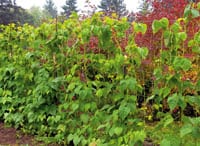
Trellis-worthy edibles
Any vining or sprawling plant with fruits smaller than a bowling ball can be trellised as long as there is a sturdy, tall structure that’s strong enough to support the weight of the mature plant and resulting fruits.
Lightweight trellis structures are often adequate to support the weight of cucumbers, pole beans and peas. Those needing sturdier support include indeterminate tomatoes, nonbush varieties of summer squash and small-fruited winter squash. A heavy-duty trellis is required to support the weight of grapevines and nonbush varieties of small melons or pumpkins (bowling ball size or smaller) and winter squash. Support developing melons, pumpkins and squash with a sling made of nylon stockings or other stretchy material on the trellis, and place the developing fruit in the sling. The added support will ensure that the fruit stays on the vine and doesn’t cause the vine to break.
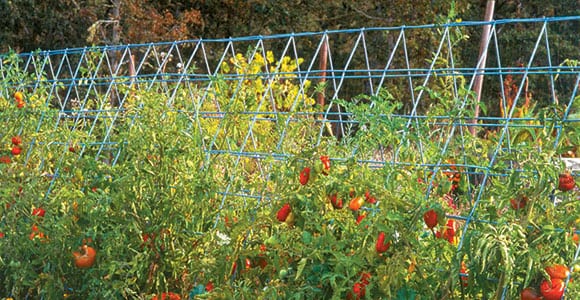
Trellis tips
- Keep plant roots and seeded beds intact by installing your trellis in place before planting in the garden.
- Choose netting or panels with large openings for easy harvests.
- Set your trellis firmly in place by sinking trellis posts about 12 to 24 inches deep.
- Vertical-frame trellises are often set side-by-side in a straight row. But arranging them in a zigzag pattern, as an arbor or with spacing between frames will create different areas and microclimates for raising low-growing plants.
- Ideally, a trellis should be portable or relatively easy to dismantle as it’s difficult to rototill a bed when a permanent trellis is in place.



